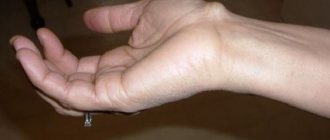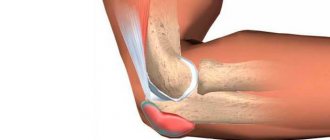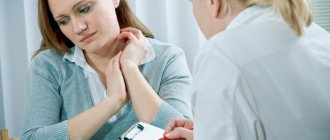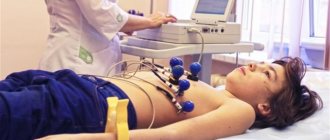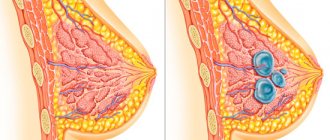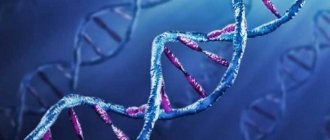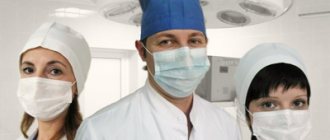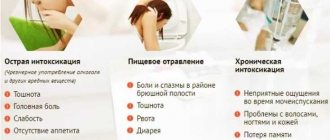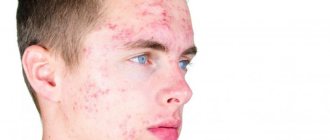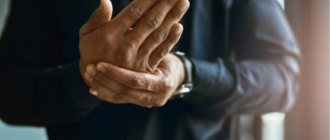A sprain ruptures the connective tissue fibers and is manifested by acute pain, swelling and subcutaneous hemorrhage. Tissues capable of regeneration can recover on their own. Treatment with cold, rest, and therapeutic exercises accelerate recovery. In trauma practice, the diagnosis of sprain is made quite often. Twisting your leg or making a sudden movement with your knee is possible in any situation. Damage to the ligamentous apparatus is treated by resting the affected limb, using cold, specially designed physical activity; if the prognosis is unfavorable, surgical intervention cannot be avoided.
A little anatomy of sprains
In medical terminology, ligaments are the formations that secure the skeleton and internal organs in the body. They are represented by highly elastic tissue, which consists of connective cells of a dense structure.
The elasticity of the ligaments in the joints differs, with which movements in different directions or inhibition of the motor process in moving joints are possible. The connections that hold all the internal organs in the correct position have a fixed structure to provide a stable location for the heart, kidneys, liver and other organs.
Violation of the integrity of the ligaments leads to the loss of the ability to perform their main function in the body. Joints become pathologically mobile, internal organs are displaced from their anatomical position, changing general physiology.
Pathogenesis of injury
A sharp jerk in a joint with movement, an amplitude unusual for this joint, exceeding all permissible values, leads to a sprain. The knee and ankle joints are most susceptible to injury.
Stretching is always accompanied by mechanical tearing of the connective tissue. With a mild degree of sprain, microdamages are formed; a jerk with great force leads to a complete rupture of the ligament. The damage is accompanied by severe pain with the formation of edema and hematoma.
Ligaments have the property of self-healing, having a high degree of regenerative ability. Connective tissue grows together without therapeutic assistance, even after a complete rupture. To do this, it is necessary to ensure rest and subsequently dosed physical activity.
Causes
Ankle sprain is one of the injuries that every person has received throughout his life and often tries to treat it at home. Injury occurs when the elastic strength of the connective tissue is exceeded and several fibers are torn.
Ankle ligaments are injured when:
- Falling.
- Increased physical activity.
- A sharp turn of the foot.
- Wearing uncomfortable shoes.
- Mechanical leg injury.
The causes of stretching are:
- frequently recurring injuries, microtears of ligaments and muscles during falls, sharp turns, or twisting of the foot;
- unnatural joint movement;
- constant load on undeveloped ligaments by athletes;
- excess body weight;
- weakness of connective tissue (both congenital and acquired);
- flat feet;
- inflammatory and arthritic changes in the joint;
- difference in the length of the lower limbs;
- diseases that block nerve conduction and muscles (myasthenia gravis, etc.).
Causes of sprains
Every person has a risk of getting a sprain, regardless of gender and age. Injury is possible due to falls, intense physical movements, a simple tripping or twisting of the foot. People actively involved in sports, as well as people working in difficult occupations.
Professional athletes in every sport can experience an injury that occurs as a result of movements in a specific joint that is most involved in a given sport. The likelihood of falling increases during icy conditions or wet roads after rain. Workers at heights, loaders and other occupations that involve lifting or moving heavy objects put themselves at risk of injury.
There are a number of diseases that are provoking factors for the possibility of getting a sprain:
- overweight;
- drooping arches of the feet;
- degenerative processes in joint tissues;
- developmental anomalies of the musculoskeletal or ligamentous system;
- relapses after previous injuries.
Sprains of the hand and wrist: treatment, symptoms, home therapy
A sprained ligament in the hand can cause loss of performance, so you should not ignore the problem. After an injury, you should not make sudden movements with the injured limb, lift weights, or perform heavy physical work, despite the pain.
If, 2-3 days after the injury, swelling occurs in the wrist area and the body temperature rises, then this phenomenon is dangerous to human health. You need to go to the emergency room immediately.
You cannot steam the injured limb and self-medicate. Therapy at home is possible, but only after consultation with a doctor.
Diagnostics
The diagnosis of hand sprain is made based on a visual examination, as well as CT or MRI results. X-rays are not always informative. An x-ray is ordered to rule out a fracture.
What is the danger?
Sprained wrist ligaments are fraught with complications. Quite often it is not possible to restore normal hand mobility. All negative consequences are characterized by destructive and degenerative processes, the most common of which are hemarthrosis, joint stiffness and synovitis. There is a high risk of wrist instability and, if the ligaments are torn, a wrist fracture.
Treatment
Treatment of hand sprains is complex. It includes drug therapy, massage, exercise therapy, physiotherapeutic procedures and wearing special bandages.
If the arm is severely sprained or a tendon rupture occurs, then surgical intervention is necessary. The damaged ligaments are sutured.
Drug therapy:
- Use of painkillers. Ice will not help with severe pain. Novocaine blockades are used, freezing sprays are applied, the affected area is treated with an ointment with an anesthetic effect - Cold Spot.
- Anti-inflammatory drugs. Sprains are treated with Voltaren, Ketoprofen, Diclofenac.
- Cooling ointments. This is Gevkamen.
- Warming ointments. They are suitable for eliminating infiltrates. This is Apizartron, Nicoflex or Viprosal.
- Vascular strengthening agents. To eliminate the symptoms of hemorrhage, Troxevasin and Venoruton are suitable.
- B vitamins. This is Neurorubin.
The course of treatment is 10-30 days. First, medications are used in the form of injections and tablets, and then they move on to the use of local drugs.
Along with medications, it is important to use therapeutic procedures:
- magnetic therapy;
- electrophoresis;
- paraffin applications;
- laser therapy.
To restore the functioning of the wrist, therapeutic massage is performed.
A sprained ligament in the hand rarely goes away without a trace. After treatment, it is important to follow preventive measures to prevent complications. Regardless of the degree of damage, you need to provide complete rest to the joint.
Prevention
Preventive measures are simple. It is enough to avoid injuries and not overwork your wrist. Static exercises are useful to help improve endurance and strength of the tendon system.
A sprain, despite its seemingly harmless nature, is a serious injury. This damage needs treatment, otherwise there is a high probability of degenerative processes in the joints.
Oksana Belokur, doctor, specially for Ortopediya.pro
Degree of damage
There are three degrees of severity of a sprain:
- With a mild injury, microscopic tears of the connective fibers appear. The joint swells a little, pain is present, but without pronounced manifestations, deformation is not observed. The victim can move independently, limping slightly, but with difficulty leaning on the injured leg.
- With a moderate form of sprain, collagen fibers are torn, which increases the flow of fluid at the sprain site, a bruise forms, and the pain syndrome is felt more acutely. Stiffness and contracture appear in the joint; all attempts to step on a limb with stretched ligaments end in severe pain; movement requires support in the form of crutches or a cane.
- The severe form is manifested by complete rupture of the ligament. The sprain site swells greatly, extensive hemorrhage appears, and the pain syndrome becomes more intense. The joint, the ligaments of which have burst, becomes hypermobile, a pathological change in the direction of the bones in relation to each other, which are included in the movable joint, is noticeable.
Symptoms of a sprain
A sprain occurs instantly, careless movement and the victim feels acute pain of high intensity. The place where the ligament is stretched swells before our eyes. The victim is unable to lean on the injured joint; if there is damage in the ankle area, the foot may change its position relative to the lower leg, with the front part directed inward.
If the movement was very sharp, a moderate or severe degree of damage is possible. In this case, at the moment of damage, you can hear a distinct click in the joint, reminiscent of the sound of a broken string. This phenomenon indicates a violation of the integrity of the ligament.
The pain present in the injured joint intensifies if you try to turn the limb towards the damaged ligament. Unpleasant pain will be felt if you try to lightly press on the place where the connective tissue attaches to the bone.
The site of the sprain swells, and often the accumulated fluid enlarges the leg at the ankle to the size of the thickest part of the calf. On the second day, the skin may become hot to the touch. If subcutaneous hemorrhage occurs, the hematoma will gradually appear a couple of centimeters below the injury.
When individual fibers are damaged, the joint becomes stiff and movements in it become significantly more difficult. A complete rupture is characterized by the opposite condition: movement in the joint is no longer limited by the ligaments, so characteristic instability appears even when passive movements are attempted.
Behind the bright clinic of a sprain, you may not notice the signs of complications that can accompany connective tissue damage. For example, when moving the leg inward, a fracture of the dome of the talus may be hidden, in which sprain of the anterior talofibular ligament is a concomitant complication. Rotating the leg in the opposite direction can result in an avulsion fracture of the medial malleolus.
How to distinguish a fracture from a ligament rupture:
- severe pain when pressing on the bone in the sprained area above or below the attachment point to the ligament;
- the pain remains constant, not going away even during sleep;
- the toes of the toe or hand on which the injury occurred do not move;
- at the moment of injury, the crunch of a breaking bone is heard;
- deformation with displacement in an unnatural way.
Treatment
Even with a seemingly minor sprain, it is necessary to visit a doctor. Despite the obvious signs of a sprain, it is not worth drawing conclusions on your own, much less treating the injury. Self-medication in the future can lead to repeated sprains due to ankle instability. An x-ray will show the true picture of the damage. Based on x-rays and visual inspection, the degree of sprain will be determined.
Related article: What to do if you have a sprained foot?
If the first degree is present, treatment at home is possible, which consists of resting the injured leg for several days and using an analgesic ointment:
- Nurofen;
- Nise gel;
- Troxevasin;
- Apisatron;
- Voltaren.
With the second and third degrees of sprain, medical supervision is necessary. Treatment can be outpatient or inpatient and includes:
- Pain relief with painkillers - tablets (Analgin, Tempalgin, Ibuprofen, Nurofen, Sedalgin, Ketoprolak, Nimesil), injections, compresses, pain-relieving ointments or gels containing menthol.
- Relieving swelling - cold compress, Heparin ointment.
- If necessary, remove the hematoma and blood accumulated in the joint cavity - Troxevasin, Bodyaga, Heparin ointment, Troxerutin.
- Physiotherapeutic procedures.
- Prevention of inflammation in the presence of a hematoma or damage to the integrity of the skin of the ankle with anti-inflammatory and antiviral drugs - Voltaren, Ibuprofen, Dolobene.
- A rehabilitation period for the regeneration of ligamentous tissue, restoration of ankle functionality, strengthening of the ankle ligaments and muscles.
For all types of sprains, the joint should be secured with an elastic bandage of medium stretch. A week for the first degree and at least a month for the second. After two days, cooling ointments are replaced with warming ones:
- Finalgon;
- Viprosal;
- Dolobene;
- Apizartron.
If the sprain of the ankle joint is accompanied by a severe dislocation, closed or open fracture, treatment is only inpatient, and it may be necessary to apply a plaster cast. If the ligaments are completely torn, they are stitched together.
Folk remedies for ankle sprains
Treatment of ankle sprains at home can be done using traditional medicine. The following recipes exist:
- A compress of chopped onion with a tablespoon of salt will help relieve swelling and prevent inflammation. Apply to the injured shin and bandage it.
- If you are not allergic to bee products, you can make a compress of honey with the addition of vinegar.
- Mashed raw potatoes help.
- Milk or vodka twenty-minute compress or two-hour lotion.
Making compresses or lotions is an individual decision, but you must remember that this is not a panacea, examination by a doctor and treatment under his supervision is necessary. Often, after self-medication, you have to deal not only with a sprain, but also with complications that arise from untimely treatment.
Diagnostics
To identify sprains, the following procedures are performed:
- stress testing: during the examination, the doctor makes specialized movements of the affected limb to determine the degree of stability of the joint;
- X-ray examination: the picture is taken in two projections to exclude the possibility of a fracture;
- computed tomography if a more detailed picture of the lesion is needed.
During the examination, the medical specialist palpates the site of the injury where the sprain occurred. When asked to take a few steps, it is noticeable how seriously the ligament is injured. Age over fifty years is an indication for differential diagnosis to identify bone fractures.
Therapeutic measures for sprains
In the first minutes after an injury, it is important to provide first aid followed by transporting the victim to a trauma center:
- place the patient on a hard surface, place a rolled up roll of clothing or improvised materials under the leg or arm that made the sudden movement;
- provide immobilization of the limb by applying a splint;
- give an anesthetic - Baralgin, Ketanov.
Basic treatment
After determining the degree of sprain, treatment is prescribed. A minor injury can be successfully treated at home, but a victim with a complete rupture can be hospitalized in a hospital.
In the first two days, the limb with damaged ligaments should not experience stress. Complete rest is ensured by light fixation with an elastic bandage or compression orthosis. In case of multiple ruptures of collagen fibers, a rigid fixation bandage is prescribed; in exceptional cases, when complete immobilization cannot be avoided, a plaster cast or a splint made of polymer bandages is applied.
For the first two days, cold compresses are applied every 3 hours for 15 minutes to reduce pain and swelling; warming procedures are allowed only on the third day. The patient should spend most of the time in a lying position, creating an elevated position for the injured limb.
Medicines
To relieve pain and inflammation, non-steroidal anti-inflammatory drugs are prescribed - Diclofenac, Indomethacin, Ibuprofen. Short-term symptom relief will be provided by non-narcotic analgesics - Baralgin, Pentalgin, Analgin.
Local treatment can be provided with ointments and gels - Dolobene, Voltaren, Fastum gel, but only during the period when warming is allowed. At first, you can use the pain-relieving gel Nise, which does not have a warming effect. If the pain cannot be eliminated by taking tablet forms, lidocaine or novocaine blockades are performed.
Surgery
In severe cases, when the ligaments, despite the regeneration function, do not grow together for a long time, surgery is prescribed. The two pieces of connective tissue are sutured or attached to the adjacent ligament.
Physiotherapy
When the pain and swelling subsides, therapeutic exercise is prescribed for recovery. The time period after injury is divided into several time stages. For each segment of recovery, a set of therapeutic exercises is compiled, taking into account the characteristics of a particular case.
In the first week, classes are conducted in a gentle manner, exercises are performed slowly and smoothly. Monitoring compliance with recommendations for load and technique of movements is carried out by a physical therapy doctor. In the second week of classes, more complex exercises are added and the number of repetitions increases.
2 weeks are added to each subsequent period, and the exercises are of a strength nature to train the ligaments. Gradual rehabilitation allows you to abandon the cane and restore the full range of motion in the damaged joint.
Auxiliary procedures
Modern methods of physiotherapeutic treatment of sprains are an excellent addition to primary therapy. Magnetic therapy promotes the regeneration of connective tissue of ligaments. Penetrating to a depth of 7 cm, the pulsed magnetic field has a therapeutic effect on cells, normalizing metabolic processes.
Local cold treatment is called cryotherapy. The body's response to cooling in the form of launching recovery functions in case of sprained ligaments. During the procedure, the injury site is blown with cold air two degrees below zero.
How to treat sprained ligaments - medications, list of drugs
A sprain is an injury that occurs as a result of strong mechanical impacts when performing active and strenuous exercises or sudden movements. The damage is accompanied by complete or partial rupture of connective tissues and ligaments that connect different parts of the skeleton.
This is an unpleasant injury that can affect people of different ages and genders. But it is especially common among athletes and workers whose profession involves heavy physical labor. It is important to know how a sprain is treated, what measures and medications are used for this injury.
First aid
To alleviate the condition and prevent complications, you must know how first aid is provided for sprained muscles, ligaments and tendons. It is important to carry it out as soon as possible so that there are no displacements or breaks in the future.
So, when carrying out first aid, you should follow the sequence of actions:
- The first step is to completely immobilize the limb. It is recommended to maintain complete rest for 2-3 days after injury. This can prevent severe stress on the affected muscle and ligamentous tissues.
- Applying cold. To reduce signs of swelling and discomfort, it is recommended to apply an ice bag or heating pad to the damaged area.
- To reduce the likelihood of complications, it is worth fixing the damaged area. To do this, it should be bandaged with an elastic bandage or an orthopedic bandage (caliper), these measures will speed up the restoration of damaged ligamentous tissue. At night, it needs to be removed to normalize blood circulation;
- Anesthesia. To reduce discomfort and pain, you should take anti-inflammatory and analgesic tablets for sprains. The most effective ones include Ketanov, Ibuprofen, Nurofen, Nise, Ketorol.
After first aid has been administered for a sprained muscle, ligament, or tendon, you should immediately call a doctor. The specialist will conduct an examination, identify the type of damage and prescribe effective treatment.
Types of drugs for sprains
How to treat sprained ligaments? Usually, for this injury, external agents are prescribed in the form of ointments and gels. They can have different effects - cooling, warming, analgesic, anti-inflammatory effects. But before using it, you should carefully study the properties and rules of use.
Cooling
Sprains can be treated with ointments with a cooling effect. They have a cooling effect on the damaged area. They help reduce pain, swelling of tissues, and alleviate the general condition. These medications are prescribed during the first days after injury.
A specialist can tell you how to treat a sprain using cooling external medications. He selects a suitable remedy, prescribes a regimen and period of its use.
The following are effective ointments with a cooling effect that can be used in the treatment of this injury:
- Myoton. The product is based on medicinal plants, oils, and other additional components. Recommended for use to relax muscle tissue. The drug has antiseptic and anti-inflammatory effects. It is recommended to apply the largest amount of ointment to the area of muscle tissue and tendons with damage. Rub in with light movements until completely absorbed;
- Flexall. This ointment has a strong effect. It is used to eliminate the feeling of overstrain in damaged muscles and ligaments. Additionally, the drug has analgesic and anti-inflammatory effects;
- Bystrumgel. The gel has a strong cooling effect and perfectly eliminates inflammatory processes in the joints. Recommended for use in case of injuries to tendons, ligaments, and joints. When used, the medicine relieves pain, swelling, and eliminates inflammation.
Warming
Ointments with a warming effect help eliminate pain in muscles and joints. They should be used for various injuries and bruises. They increase blood circulation in damaged areas and speed up recovery.
Warming medications for sprains are recommended to be used in the first 3-4 days after injury. The most effective are the following:
- Venoruton-gel. The product has a positive effect on the tone of the veins. Recommended for use in cases of musculoskeletal injuries. After applying it, swelling and soreness in the muscle tissue disappear;
- Dolobene. The external drug has an analgesic effect. Relieves symptoms of swelling and puffiness. Eliminates hematomas, inflammation in muscles and tendons.
Painkillers
How to cure a sprain if the injury is accompanied by severe pain and discomfort? In this case, the doctor may prescribe an external remedy with an analgesic effect.
The most effective and efficient are the following:
- Dolgit. This is an analgesic external agent that has an anti-inflammatory effect. After the first application, swelling decreases and swelling disappears. It is recommended to use for sprained ligaments, tendons, and muscle tissue;
- Capsicam. It contains a potent substance – dimethyl sulfoxide. It is able to penetrate deep layers of tissue. After application, unpleasant feelings disappear, blood circulation improves, all this contributes to the rapid restoration of damaged ligamentous tissue;
- Finalgon. The composition contains an active element with a strong effect - nonivamide. It causes vasodilation, has a positive effect on blood circulation, and eliminates pain in the muscles.
Anti-inflammatory
Treatment of sprained ligaments, tendons, and muscles is often accompanied by medications that contain antibiotics. They eliminate inflammation, pain, and speed up the recovery process. If there is an inflammatory process, it is not recommended to use ointments with a warming effect, because they can cause complications.
All antibiotics for sprains should be prescribed only by a doctor, depending on the patient’s condition. The following external agents with anti-inflammatory effects are popular:
- Ketonal. External drug with analgesic effect. It helps alleviate the condition and eliminates the inflammatory process. Accelerates the recovery process;
- Amoxicillin and Penicillin. Antibiotic medications may be prescribed for sprains if there is injury and inflammation. They are especially often prescribed by a doctor when an infection occurs;
- Diclofenac. The drug contains diclofenac sodium. It penetrates into the deep layers of the skin, accumulates and eliminates inflammation. It is recommended to apply the product several times a day until the unpleasant process is completely eliminated.
Let's sum it up
Only a doctor can determine how to treat a sprain with medications. He must first conduct an examination, establish the degree of complexity of the injury, the depth of the lesion, and after that he selects the most suitable external remedy.
Under no circumstances should you self-medicate, as this can lead to worsening of the condition and unpleasant consequences.
Interesting video
Source: https://bitravma.com/travmy-svazok/lekarstva-pri-rastazenii-svazok
Prevention of sprains
You can partially protect yourself from sprains by following these recommendations:
- create a daily diet menu based on products included in the healthy diet list to maintain normal weight and provide connective tissue with the required amount of vitamins and minerals;
- do simple physical exercises to train the ligamentous apparatus;
- choose comfortable low-heeled shoes for everyday wear;
- avoid intense physical activity;
- wear protective orthopedic products to prevent sprains;
- contact a traumatologist if there is a sharp jerk in the joint for a detailed examination in order to respond to associated injuries in a timely manner.

